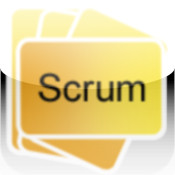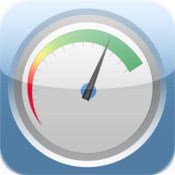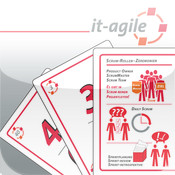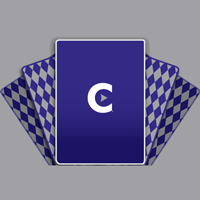There’s an app for just about everything these days, including developer productivity. Some of them have been created by tool providers, while others have been built by consultants or individuals.
Given the niche market for these apps, there are not a lot of them compared to other categories, leaving much room for innovation. Those that currently exist tend to focus on agile project management or project estimation via electronic Planning Poker (a.k.a. Scrum Poker) cards. Some of the project-management apps are tied to more sophisticated cloud applications, while others are relatively simple, standalone apps. The card decks are simple utilities.
This article describes 10 of the most popular free and paid apps you can download from the Apple App Store for iPads and iPhones.
This app is the most popular iPhone and iPad app for software-development productivity, according to the App Store’s rankings. It was developed by agile consulting firm Pivotal Labs as an extension of its Pivotal Tracker agile project-management website.
The iOS UI is similar to the Pivotal Tracker website dashboard, so users can get familiar access to the status of a project, plan a release, and view the stories they own.
Pivotal Tracker can be used to plan an iteration simply by creating stories, which is as easy as clicking on an icon and entering such information as the name, difficulty estimate, owner and description. Created stories show up in the icebox and can be moved on the iPad version by clicking on the start button. The iPhone version does not allow the user to change the story’s status until it has been moved out of the icebox, however, which one user complained about.
Another worthy criticism is that current items should appear as separate in a Current Items column like on the Web version, rather than being included as backlog items. The iPad version provides single-touch status updates via status buttons next to the story description. Using the iPhone version, the user must tap on the story, scroll down to the status and then change it. Like the Pivotal Tracker website, stories can be filtered or searched for by keyword. The app also includes a My Work panel of stories requiring the user’s attention.
User reviewers generally love the app because it is easy to use and is a solid project-management tool.
In addition to providing online access to projects, Pivotal Tracker for iOS stores a complete copy of a project so it can be read offline. That way, the user can switch panels or search for a story without having to reload the project from a server. Syncing is accomplished with a single screen tap.
Pivotal Tracker was last updated Nov. 10, 2012, to include bug fixes and improvements.
#!
GoTask is a Scrum and Get Things Done (GTD) project-management tool that allows users to create projects in one place. Scrum team members can use the app to plan, estimate and track multiple agile projects, although only the iPad version allows product backlogs to be managed via a task board.
Either the iPhone or iPad versions can be used to create and estimate user stories, rank them, tag them, break them into subtasks, assign them to releases and sprints, or move them between sprints. Users can also start or stop sprints or sprint notifications, set up the sprint velocity, and schedule or monitor progress using burndown charts. Projects can be shared or printed. It’s also possible to export data to HTML, XML or PDF, and then send the exported files to Dropbox, Box, CloudApp, and other FTP services. XML data can be imported.
GTD features are similar to the Scrum features in some cases and identical in others, and are adjusted as necessary to suit the GTD method.
This app was updated on Feb. 14, 2013, to include bug fixes and improve the app’s stability.
#!
PlanningPoker provides an electronic card deck for playing Planning Poker, which is a consensus-based technique for estimating the effort or relative size of user stories. (The Planning Poker agile planning technique, invented by James Grenning and popularized by Mike Cohn in “Agile Estimating and Planning,” is most strongly associated with Extreme Programming and Scrum.)
Rather than discussing or debating time estimates verbally ad infinitum, this app allows each participant to select a card corresponding to his or her estimate of difficulty or time. When a user selects a card from all the possibilities shown on the screen, the card flips over to display the back, hiding its value. When all participants have selected a card from their respective decks, they show them simultaneously and continue rounds until a consensus is reached. To show or hide the card’s value, the user simply touches the card’s electronic representation on the screen.
This particular app’s “deck” uses the Fibonacci sequence (0, 1, 2, 3, 5, 8, 13, 21, 34, 55 and 89) and includes four other cards: ½, infinity, unsure, and a coffee cup (representing break time). The Fibonacci sequence reflects the uncertainty that comes with estimating large items. By comparison, some other physical and electronic Planning Poker decks use similar sequences up to and including the number 13 followed 20, 40 and 100.
PlanningPoker is also available from GitHub. Users like its simplicity and ease of use. It is designed for offline use like a physical deck of cards rather than online single-screen group participation.
The app was released on Sept. 20, 2011.
#!
AgileMeter helps software teams assess their level of agility based on their alignment with Agile Manifesto principles. Small groups can participate in the assessment using their iPads or iPhones with the goal of providing quick insight into the team’s readiness to adopt five basic agile/Scrum practices, including managing requirements using a backlog; working in iterations; group estimation; daily standup meetings; and self-organized teams. The app groups different team roles into Builder and Planner roles.
This app was released on Jan. 4, 2011.
#!
Code Monkey contains an RPM-capable programming calculator designed in the spirit of old HP calculators. It also includes a regular-expression cheat sheet and a quick design pattern reference guide. The regular-expression cheat sheet includes anchors, character classes, POSIX character classes, assertions, quantifiers, special characters, string replacement, ranges and pattern modifiers, all of which are selectable by group via a spinner control. The design patterns reference guide also provides easy spinner control navigation. It includes Adaptor, Builder, Bridge, Composite, Decorator, Façade, Factory, Flyweight and Singleton class diagrams.
The iPad version also includes a UML editor that supports multiple class diagrams, classes, dependencies, derivations, and realization relationships between them. The classes and relationships can have names that appear on diagrams and stereotypes. The diagrams can be e-mailed as PDFs as well as saved as PNGs to the device. User reviewers seem to like its functionality as a calculator best.
The app was updated Aug. 11, 2011, to include bug fixes.
#!
This newly released app has already become one of the top software-development productivity apps for the iPad, although at the time of this writing, only one user had written a review. AgileZen is an extension of Rally’s AgileZen 2.0 beta. AgileZen is a real-time project-collaboration solution that allows users to visualize work and progress using a Kanban board. The board shows all of the work (cards) in progress as they move through workflow phases.
The simple navigation allows users to rapidly access and view work spaces, create new cards, perform searches, adjust basic project settings, add or remove members, and edit project phases. The cards when added or tapped give the user options for adding tasks, assigning owners, adding notes and attachments, defining or changing the status, or viewing the history of the card. As work phases are completed, the cards move from left to right.
At present, the planning screen is not viewable on the iPad like it is on the website. Therefore, if a user selects Unsorted, Someday or Soon from the planning options, or moves a card to the planning screen using the phase selector, the card is no longer viewable from within the app; it can only be viewed on the Web.
The app syncs activity between the iPad app and the cloud app, so distributed team members have access to the latest information via shared Kanban boards that facilitate collaboration and communication. The sole reviewer liked its ease of use, and it is very easy to use.
The app was released on Jan. 14, 2013.
#!
Agile PM is an agile project-management tool for managing and tracking agile projects in one place. It allows users to define and prioritize stories, assign users to stories, define sprints and their start/stop dates, and define the stories that must be completed for each sprint. When a user adds a story, the initial screen allows him or her to name it, prioritize it, and assign story points from 1 to 50. Users can also define projects, teams and stories assigned to individuals, as well as create a master product backlog of all agile projects. The app further includes a burndown chart for tracking the progress of each project and sprint.
Agile PM was released June 16, 2012.
#!
This app includes an electronic Planning Poker deck, which comes with Planning Poker rules and a Scrum tutorial. The card deck includes 0, 1, 2, 3, 5, 8, 13, 20, 40 and 100 numeric cards.
The UI animation varies slightly from the PlanningPoker app. A PlanningPoker card, when tapped, maximizes the chosen card’s image and then flips to display the back of the card, hiding its value. When the user taps the card, its value is revealed. By comparison, when a Scrum Cards card is tapped, the entire deck appears to flip and the value of the selected card is displayed. The practical effect is that Scrum Cards enables one-tap operations, while PlanningPoker provides two-tap operations. Like PlanningPoker, ScrumCards is designed for offline use like a physical deck of cards rather than for online single-screen group participation.
The Scrum tutorial includes the Agile Manifesto, a white-board description of how Scrum works, and colored sticky-note representations of Scrum Values. It also includes a description of Scrum roles, ceremonies and artifacts. There is also a graphical representation of a Taskboard; definitions of “Ready” and “Done”; an explanation of INVEST criteria; and descriptions of user stories, epics and themes, among other things. It further includes checklists for Scrum basics, product owners, ScrumMasters, development teams, and ceremonies.
This app’s addition of Scrum tutorials, Planning Poker rules, and checklists to an electronic Planning Poker deck make for a valuable, easy-to-use tool that should be in every Scrum team member’s pocket.
This app was updated March 22, 2012, so the description cards correspond to the Scrum Guide 2011.
#!
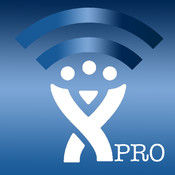
JIRA Connect Professional, by Martin Luethi
Price: $4.99
Requires iOS 5.0 or later
3.5 stars, 4 ratings
JIRA Connect Professional connects to any Atlassian JIRA instance version 5.0 or above, including JIRA OnDemand. It uses JIRA’s RESTful API, which is enabled by default, so configuration changes are generally not necessary. The app allows users to create, edit and assign issues; transition issues through workflows; log work; view attachments; and enter comments.
The app was updated on Jan. 26, 2013 to include bug fixes, performance improvements and enhancements. Users love it or hate it based on their ability to log in.
#!
Centare Planning Poker provides a virtual card deck like PlanningPoker and ScrumCards. Unlike PlanningPoker and ScrumCards, it allows users to create a virtual table for a planning-poker session and invite other team members to connect using a table code. Because the host sends out the invites, the host also controls the rounds of voting. As members cast votes, their cards appear face down until the last person has voted. The cards then flip over to reveal the results. The app also arranges the cards from low to high automatically.
This electronic deck’s card sequence is 0, ½, 1, 2, 3, 5, 8, 13, 20, 40 and 100. Users seem to like the table concept because it works well for distributed teams, although some would like to see unsure and coffee-break cards added.
The app was last updated on Feb. 15, 2012 with a bug fix and an enhancement that allows offline voting.


